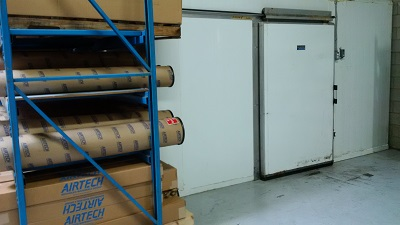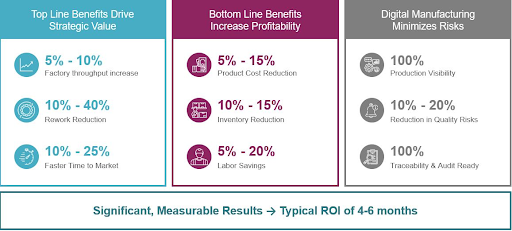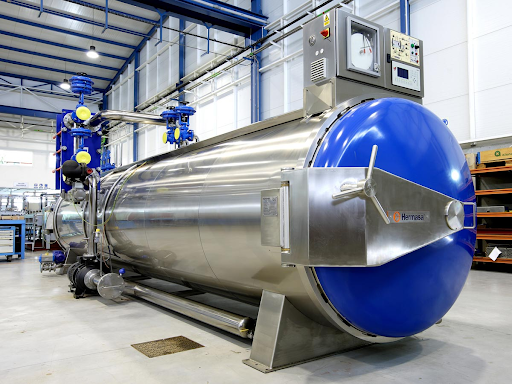Under pressure from global material and workforce shortages, the rising prices of raw materials, and the growth in demand, Aerospace composites factories today acknowledge the need for digital acceleration. They have started to adopt new smart-factory technologies in order to become more agile and effective, increase profitability, boost productivity and cut costs.
While many believe the COVID-19 pandemic created the current supply chain challenges, it actually worsened challenges that had already existed. Aerospace & Defense are among the industries most affected by supply chain disruption. In response, supply chain manufacturers increasingly turn to smart factory, Industry 4.0 technologies, to maximize productivity and efficiency and save costs through hyper automation and predictive analytics. Hyperautomation 2.0, for example, which leverages AI and machine learning to automate production processes, gains wider adoption, according to recent Gartner research.
The Aerospace composites manufacturing industry, in particular, is investing in hyperautomation, IIoT, and software with AI-based predictive capabilities. Manufacturers rely on these advanced technologies to automate repetitive manual tasks and adapt to changes in real time, making them much more resilient. These technologies help them optimize the use of expensive composite materials to reduce waste and save money.
With factory digitization and optimization process in mind, these are the key steps that can be identified:
- Plan and strategize
- Assess current situation and areas for improvement
- Set KPIs
- Find the best vendor – look for proven experience in the aerospace/composites industry
- Implementation
- Measure ROI & continuous improvement
Theory aside, what do hyperautomation and manufacturing optimization look like in real life? This article reveals the step-by-step implementation journey of a Plataine Aerospace manufacturing customer, as it leveraged IIoT and AI at its manufacturing site, automating processes in a smart production line to cut costs and boost profits.
An insider journey: Optimizing the production floor of an Aerospace composites factory
This is the story of a world-class Aerostructure composites manufacturer of jet engine nacelles that wanted to implement advanced industry 4.0 technologies to take advantage of hyperautomation, predictive capabilities, and features for composite material savings. The sequence of manufacturing operations at a high level looks like this:
1. Material receiving -> 2. Freezer managing -> 3. Defrosting -> 4. Cut & Kit > 5. Lamination and layup > 6. Curing (autoclaves).
Step 1: Receiving, tagging and storing composite material in freezers
Image source (Image not related to described manufacturing floor)
Receiving inventory is a time-consuming manual task that demands factory workers to register data and organize materials in the freezers – a manual and time consuming repetitive task that is prone to human error. Optimization entails automatic tracking of new inventory as soon as it arrives, using RFID sensors or barcode scanning.
Each material (i.e. roll) is registered and from then on continuously tracked via the Time-Sensitive Material Management application through its entire lifecycle – the software tracks location, condition and status of all materials and kits and automatically calculates exposure time.
With the removal of paperwork, manual registering and material tracking, the check-in process for new materials is much faster and human errors are eliminated. Inventory moves briskly from drop-off to freezer storage, extending material shelf life. Human errors are eliminated, saving costs and improving efficiency.
Optimization includes:
An example of barcode tracking with an app
Step 2 in the journey: Defrosting material
Workers often select which roll to defrost on their own, based simply on convenience (e.g. longer rolls are easier to work with, and often workers just take the ones closest to the door without giving it much thought). In our example, with material tracking software, the selection process in the factory floor is based on material optimization considering real-time data on shelf-life parameters, material length, and production demand.
This allowed for a significant reduction of material waste and also compliance with high sustainability standards.
A new capability was added – Digital Assistants send timely alerts and insightful AI-based recommendations, such as on the optimal roll to choose given the context (smart material selection). This makes material management and tracking totally automated, leading to reduced human error.
The Digital Twin – the digital representation of the factory, shows the location, condition and status of all materials. If their temperature rises above X degrees, the software automatically starts counting exposure time, triggering alerts when needed.
Automated alerts recommend exactly which materials to defrost and/or use and when, before they expire.
Automated tracking ﹘ in and out of freezer, expiration date, alerts and recommendations (e.g., allocating a specific roll to a job)
Time sensitive material management also includes traceability of inventory on the factory floor
Step 3: Cut and kit
Traditionally, a cutting plan was created to cut a predefined number of kits for just one part type, and then when a work order was received at the factory, those kits were cut over and over. As many composite manufacturers have learned, this method is inefficient and results in excessive kits that require freezer storage and expensive material waste. In our journey example, the manufacturer moved to use manufacturing optimization technology, specifically the Fabric Optimizer solution. The plans were then transformed to dynamic cut plans (based on several work orders, and could cut multiple part types using the same material from a single sheet) specifically made for the actual demand and only for the kits needed to fulfill incoming work orders.
The software also automatically assigns material to work orders and plans, optimally utilizing material, and also applying an effective remnant strategy. Also, there is no more searching for carts with needed kits — their locations are tracked and shown in real time. These optimized processes improve yield, save time & costs, and ensure compliance with audits.
Steps 4 & 5: Layup and curing
Traditionally, kits are placed in molds and then sent to the autoclaves for curing. This is all done manually, and from time to time, unbeknownst to factory workers, maintenance is needed for the mold or the autoclave. This may shut down production and cause costly delays and bottlenecks.
The Tool Manager, another smart factory application for optimizing production, automatically tracks tools using sensors, and pinpoints their location on the production floor. Workers will never lose a tool again, spend precious time searching for the needed tool, and damage or maintenance issues are alerted in advance, preventing delays.
With the addition of AI optimization, layup and curing become part of the smart manufacturing processes ﹘ making them more efficient and less vulnerable to changes and miscalculation. The software features predictive maintenance, meaning the Digital Assistant sends timely recommendations when a mold requires upkeep, asking to use alternative ones. Recommendations are sent on a predictive basis so that shutdowns can be avoided altogether. Also, the Digital Assistant intelligently coordinates molds to autoclaves to achieve optimal scheduling, maximize throughput, and save energy costs. This ensures that the autoclaves are coordinated ahead to work when full.
An autoclave – Image source (image not related to described factory floor)
Expected results and return on investment
We always track the results of the implementations on smart factory floors like the one that is featured in this article and others. The technology for Aerospace composites manufacturing optimization produces measurable impacts, as the following benchmarks show:
Summary – AI & IIoT power the smart production line
The powerful combination of IIot and advanced AI that smoothly integrate with existing software (ERP or MES) enable the benefits described above. IIoT sensors automatically track important real-time factors such as location, status, temperature and time. The sensor data collected is consumed by advanced applications (Digital Assistants) using AI algorithms that consider the present context, including upcoming demand and plans, providing actionable insights and recommendations in real time around critical areas such as material expiration, autoclave throughput, production demand, delivery deadlines, supply chain issues, etc. Together with our deep industry knowledge in Aerospace composites, these capabilities allow manufacturers to create a truly smart, hyper automated and optimized production line in their factories.
For more information, contact our digital transformation experts.










